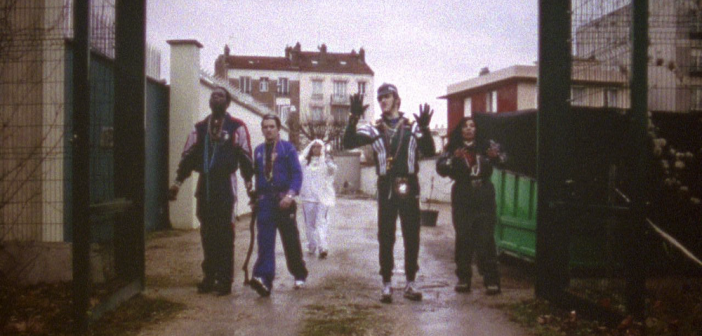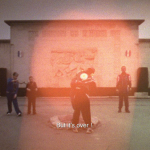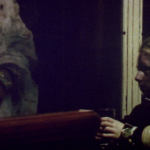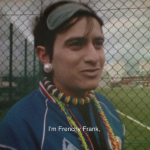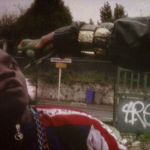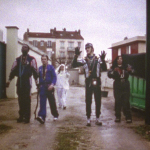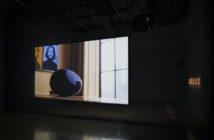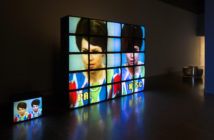One film drew me in particular: Coeurs de Silex (Hearts of Flint) (2012). The piece takes as its context and content the traumatic history of a suburban French town, Noisy-le-Sec, which was occupied by the Axis forces during WWII and bombed by the Allies in 1944. During the course of four days, Curnier Jardin gathered six actors in the city. They were given roles that, through improvisation, they would use to collectively realize a narrative that captures the traumatic effects of war. The roles outlined by Curnier Jardin were icons of sorts of wars and wartime: an Ally, an Occupant, a Witch, a Mystic, a Trainer, and a Violent Child. The film itself has an apocalyptic feel—occurring almost as if in a non-time where future and past are the present. The characters’ interactions and monologues capture some of the many traumas which occur in war: hunger, occupation, death, loneliness, militarization and preparedness, and violence, among others. Heavy stuff, yes. But let me tell you: this film is funny. It’s hilarious! And when the heaviness rubs up against hilarity, it’s electric.
What follows is my response to the film. Inspired by the surreal, musical, and poetic quality that Curnier Jardin employs in her work, I took a poetic approach to the writing. There are many threads that she pulls out with this piece, and it seemed the most fitting way to capture and weave them together.
"The abyss is filled with our friends, let’s go there without remorse!"
—One of many phrases sung by The Mystic in Coeurs de Silex
HUNGER AND THE DIRT
Dirt eating… like pregnant women and children consuming the earth for essential minerals and nutrients…
Dirt eating… a search for sustenance in a barren land?
Dirt eating… a form of domination? The ravenousness with which they eat…
Dirt eating… consuming the past, the lost history, that which remains constant (impassive) underneath the human drama of war and conflict…
Dirt eating… a metaphor for the need for humans to consume even after apocalypse (read: earth domination). What to consume when there’s nothing more for us to consume?
Dirt eating… will this barren land yield the fullness and completion one desires? Is that the only way left for us?
Dirt saving… the obsessive filling of pockets… hoarding… as if there wasn’t enough for everyone.
Dirt saving… who wouldn’t hoard in a time of war/apocalypse/lack?
Dirt saving… how does this hoarding divide us from one another? What of our capacity to live in community?
AND CAMP
Characters in drag, bedazzled with plastic bling and ridiculousness.
Drag disarms the language of violence.
Drag unites the aggressor with the defender.
Everyone is an aggressor.
Is war a form of drag?
Drag, bringing feminine tropes to the masculine language of war and violence.
The capacity for women to be violent in equal measure. Drag?
Drag… is silliness? Silly in violence. Their swag swings.
Their hilarious track suits. Hilarious.
We laugh at dark material… a disarming way into the darkness.
But humor or satire? More rightly, feminist satire?
According to me or to her?
Maybe that question isn’t helpful.
No matter. It’s political.
In Curnier Jardin’s own words: "Adventure and laughter are our only survival."
AND ALIENATION
Of beers and bar-time: all agents and victims, separate and together.
Alone with their beers, but not crying into them.
Is the aloneness also togetherness? Notice the Occupier is still on the outside.
Of beers and bar-time: the dancing, the mingling, the improvisation: violence and the results of violence as community building.
No one limps.
AND THEN, THE OCCUPIER
The Occupier, ever on the outside looking in…
The Occupier, a tourist. Exclaiming with delight at the smallest thing.
The dirt! Consumed by consuming!
The Occupier, the most bumbling, and giddy. The most silly.
The Occupier! The one whose closing monologue is most free of violence. Most filled with a need to connect, and the inability to do so.
What does it mean to invite empathy for the Occupier and the occupied? Does empathy for the Occupier make the rage and paranoia of the occupied less valid and appropriate?
Everyone is allowed empathy here.
The Witch: "I know! I feel! Can you hear me?"
Isn’t that what we’re all saying? Might this be our grand unifying force?
The baseline for future community building?
AND THE AMERICAN
Notice his black body. Notice his particular variety of mourning. Notice the way that the Witch cannot communicate with him—though she picks many languages.
What does it mean to have a black body mourn in this particular way?
Mourning and protecting the lost. Standing up for the lost and giving them voice.
I want it to be about the black body, migration narratives, race, and racism. The contemporary European conservative turn. The struggle with immigration from North Africa. The uneven distribution of wealth.
And yet his role is "the American." So what do we do with that… as Americans?
The American: "I’m going to make you see! I’m going to make you mad!"
The American: "These are my people and I will take care of them."
The Witch (read: the occupied): "Who do you think you are?"
AND THE GIRL
The young girl cannibal.
Also a cannibal casualty of war.
A child of wartime relationships… are we to read wartime rape? Is she the spoils of war, or just the results?
The spoils of history or the result?
The visibility in and of anger and righteousness in the mother/Witch literally bearing the results and reminders of wartime complexity. The complexity: love in and out of violence. Violence in and out of love?
The girl: product of a violent time. Is she therefore violence incarnate? Notice she’s violence in heels. Tamed only by the mother.
The girl: she pulls a gun on many things, but the only human animal—her military trainer.
Is there pity there, for the violent treatment by her mother?
Is she to be feared, with her arbitrary shooting and that impassive face?
But it’s a toy gun. So maybe we laugh? What is the impact of this laughing? This laughing at a girl with a gun?
AND PREPAREDNESS
The General and his repetitions. Claims on militarization and preparedness.
Naming sport (read: competition) as one foundation of future militarization and violence.
Child armies: violence training
Preparedness as a response to fear and oppression.
Preparedness as an opportunity to control the uncontrollable.
The parallels between military preparedness here and the language of preparedness vis à vis climate change and its human impacts.
Is preparedness and protection the ultimate rational response to crisis and trauma?
Is another response possible to we human animals?
AND THEN ALL THAT LIMPING
The adults limp from some kind of internal handicap. The child limps as a result of bright red high heels.
Yet everyone limps. Everyone’s been maimed.
Enter empathy stage right… yes, here we are again.
Are these limps our internalized histories? The burdens of war carried?
Cyborgs, cripples, robots, something not quite right (not quite complete? Human?)
Are these limps physical manifestations of physical traumas, inevitable in times of war?
And these limps, they turn chases, conflicts, and meanderings into clowning behavior.
Limping/traumas of war as camp.
I mean, it’s funny, isn’t it? But how do we feel, laughing at the handicapped results of war?
AND SO…
We take destruction as a given. But who is left, and what tools are left to them to rebuild? Are they beyond the invisible wall?
Or is that which is beyond something else? A different kind of way of being in the world? A different way of being together.
The Witch: "That’s enough with the deaths! I’m going to kill the dead!"
Hmmm…
You know, I agree.
List Projects: Pauline Curnier Jardin
On view at the MIT List Visual Arts Center
March 18th — May 11th, 2014
Curated by Alise Upitis, Assistant Curator, List VAC

